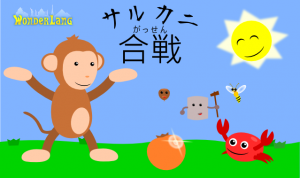Hello!
Here is the continuation of our story!

Original script: http://www.e-hon.jp/bsaruka/sarj2.htm, http://www.e-hon.jp/bsaruka/sarj3.htm
Please note that I will not recall elements that were previously introduced in the previous artile, so I advise you to have a quick look at it to freshen up your mind: サルカニ合戦 – 1
カニさん は、かき の たね を うえる と 水 を かけながら うたいました。
| 1 | うえる | ueru | Verb: うえる – to plant, to grow |
| 2 | と | to | Particle. Indicates the objective of an action |
| 3 | 水(みず) | mizu | water |
| 4 | かけながら | kakenagara | Verb: かける – to pour かけながら along with pouring |
| 5 | うたいました | utaimashita | Verb: うたう – to sing うたいました Past tense. “Was singing.” |
「はやく め を 出せ かき の たね。
| 6 | はやく | hayaku | Adverb. Quickly. |
| 7 | め | me | sprout |
| 8 | 出(だ)せ | dase | Verb: だす – to put out だせ Imperative. “Put out” |
出さぬ と はさみ で ちょんぎる ぞ」
| 9 | 出(だ)さぬ | dasanu | Verb: だす – to put out ださぬ Colloquial negative form. “Don’t put out” |
| 10 | と | to | Particle: {If}. Following a verb, iIndicates that what precedes is a condition to something. |
| 11 | はさみ | hasami | scissors, clips. Here pincers. |
| 12 | で | de | Enclitic particle: {With}. Indicates that what precedes is the mean of an action. |
| 13 | ちょんぎる | chongiru | Verb ちょんぎる – to chop something |
| 14 | ぞ | zo | Enclitic particle: {Assertion}. Indicates that what precedes is an affirmation, but brings a softer feeling to it. |
すると、みるみる め が 出ました。
| 15 | する と | suru to | Thereupon |
| 16 | みるみる | miru miru | Expression: in a twinkle, before one’s eyes |
| 17 | 出(で)ました | demashita | Verb: でる – to go out でました Past tense. “Got out” |
カニさん は、また うたいました。
| 18 | また | mata | again, still |
「はやく み よ なれ かき の 木 よ。
| 19 | み | mi | fruit |
| 20 | よ | yo | Enclitic particle: {Vocative} In a song or poetry, indicates that the speaker addresses to what precedes, here a fruit. Like “Oh, dear seed…”. |
| 21 | なれ | nare | Verb なる – to become なれ – Imperative form. |
| 22 | 木(き) | ki | tree |
ならぬ と はさみ で ちょんぎる ぞ」
| 23 | ならぬ | naranu | Verb なる – to become ならぬ – not becoming |
する と、あっと いう まに たくさん の み が なりました。
| 24 | あっ と いう ま に | a- to iu ma ni | Expression: in no time (littelery: before you could say Ah) |
| 25 | たくさん | takusan | Adjective. A lot, many. |
| 26 | の | no | Particle: {Recall}. Replaces a previsously identified noun, here the fruits. |
| 27 | なりました | narimashita | Verb: なる – to become なりました – to have become (appeared) |
「やあ、おいしそう な かき が たくさん なった ぞ。
| 28 | やあ | yaa | Wow! Expresses contentment. |
| 29 | おいしそう な | oishisouna | おいしそう refer to part 1 point 18 おいしそうな Adjective. Which looks tasty. な is used to make the adjective prenominal. かき は おいしそう です。 おいしそう な かき です。 |
| 30 | なった | natta | Verb: なる なった informal form of なりました |
どれ ごちそう に なろう か。
| 31 | どれ | dore | to what extent |
| 32 | なろう | narou | Verb: なる – to become なろう casual volitional form. “want to become”. |
| 33 | か | ka | Particle. Indicates that the sentence is a question. |
でも、ぼく は 木 に のぼれない し な。
| 34 | でも | demo | but |
| 35 | のぼれない | noborenai | Verb: のぼる – to climb, to scend のぼれない: cannot climb |
| 36 | し | shi | |
| 37 | な | na | How? |
どう しよう。
| 38 | どうしよう | dou shiyou | Expression: How can I do it? |
そう だ 木 のぼり の うまい サルさん に たのもう」
| 39 | そう だ | sou da | That’s it! |
| 40 | 木(き) のぼり | ki nobori | tree climbing |
| 41 | の | no | Particle. Linking two propositions. |
| 42 | うまい | umai | skillful |
| 43 | たのもう | tanomou | Verb: たのむ – to ask, to request たのもう – volitional form “Let’s ask…” |
Here we are! Now let’s put it together:
カニさんは、かきのたねをうえると水をかけながらうたいました。
「はやくめを出せかきのたね。
出さぬとはさみでちょんぎるぞ」
すると、みるみるめが出ました。
カニさんは、またうたいました。
「はやくみよなれかきの木よ。
ならぬとはさみでちょんぎるぞ」
すると、あっというまにたくさんのみがなりました。
「やあ、おいしそうなかきがたくさんなったぞ。
どれごちそうになろうか。
でも、ぼくは木にのぼれないしな。どうしよう。
そうだ木のぼりのうまいサルさんにたのもう」
カニさんは、サルさんのところにいきました。
「サルさんサルさん、おいしそうなかきがたくさんなっている木をみつけたよ。
でも、ぼくは木にのぼれないから、サルさんとっておくれよ」
「いいよ、カニさん、たくさんとってあげるよ」
Mr Crab, in order to grow the kaki seed, was pourring water while singing:
“Quickly, kaki seed, put a sprout out.
If you don’t, I will chop you with my pincers!”
With that said, in a twinkle, a sprout came out.
Mr Crab continued singing:
“Quickly, give me some fruits, ô kaki tree.
If you don’t, I will chop you with my pincers!”
With that said, nosooner said than done, many fruits did come out.
“Hurray! Many tasty looking kaki fruits have come out. Let’s see how tasty they are. But I can’t climb to trees… How can I do?
That’s it! Let’s ask to Mr Monkey who is skilled at climbing trees.”
Hope you did well. Getting into the Japanese state of mind takes time, so do not hesitate to read the two first articles again and again.
And do not hesitate to share this article if you found it useful.
Stéphane
Follow us: